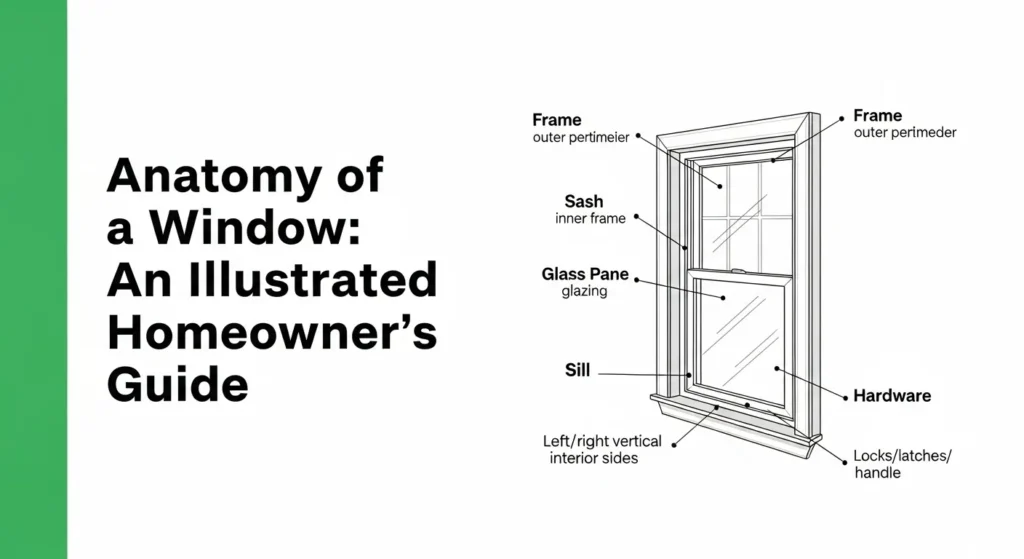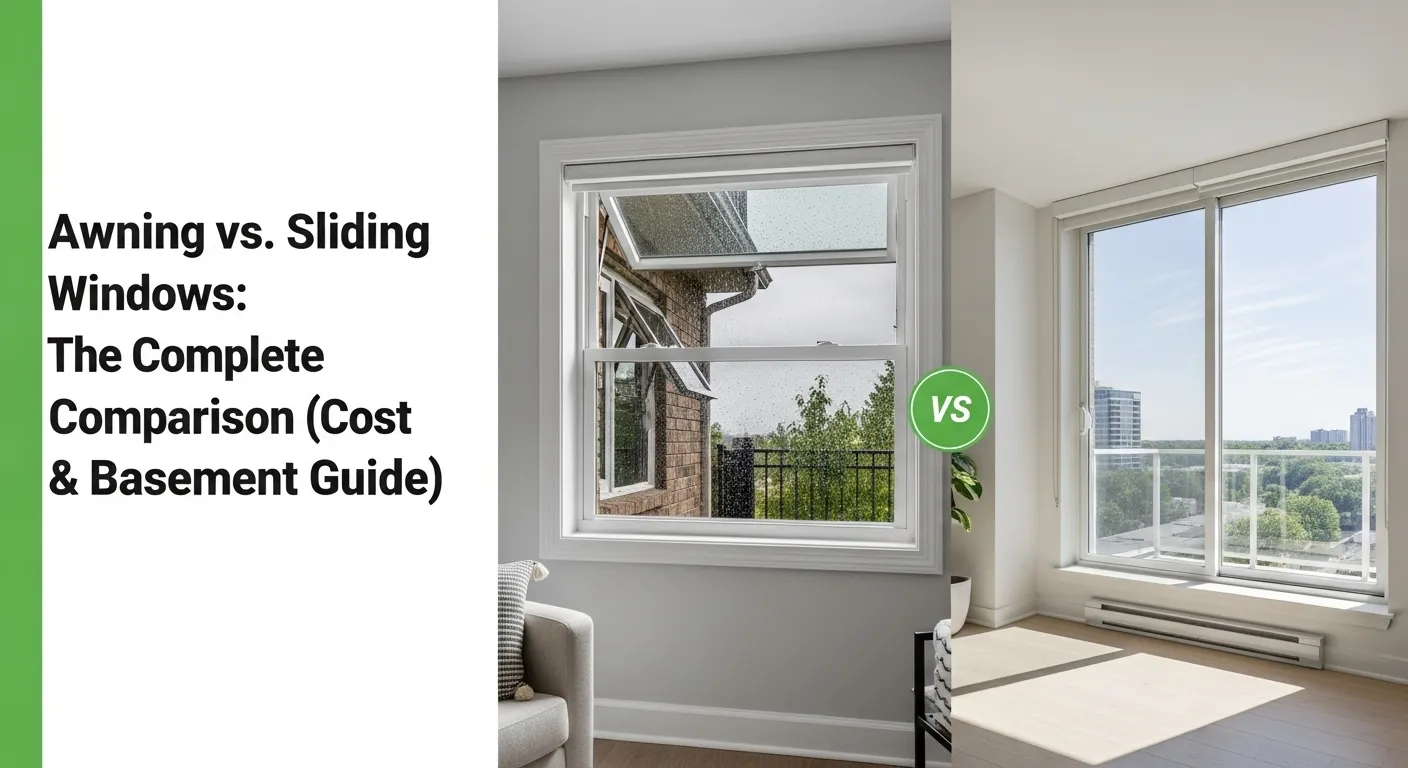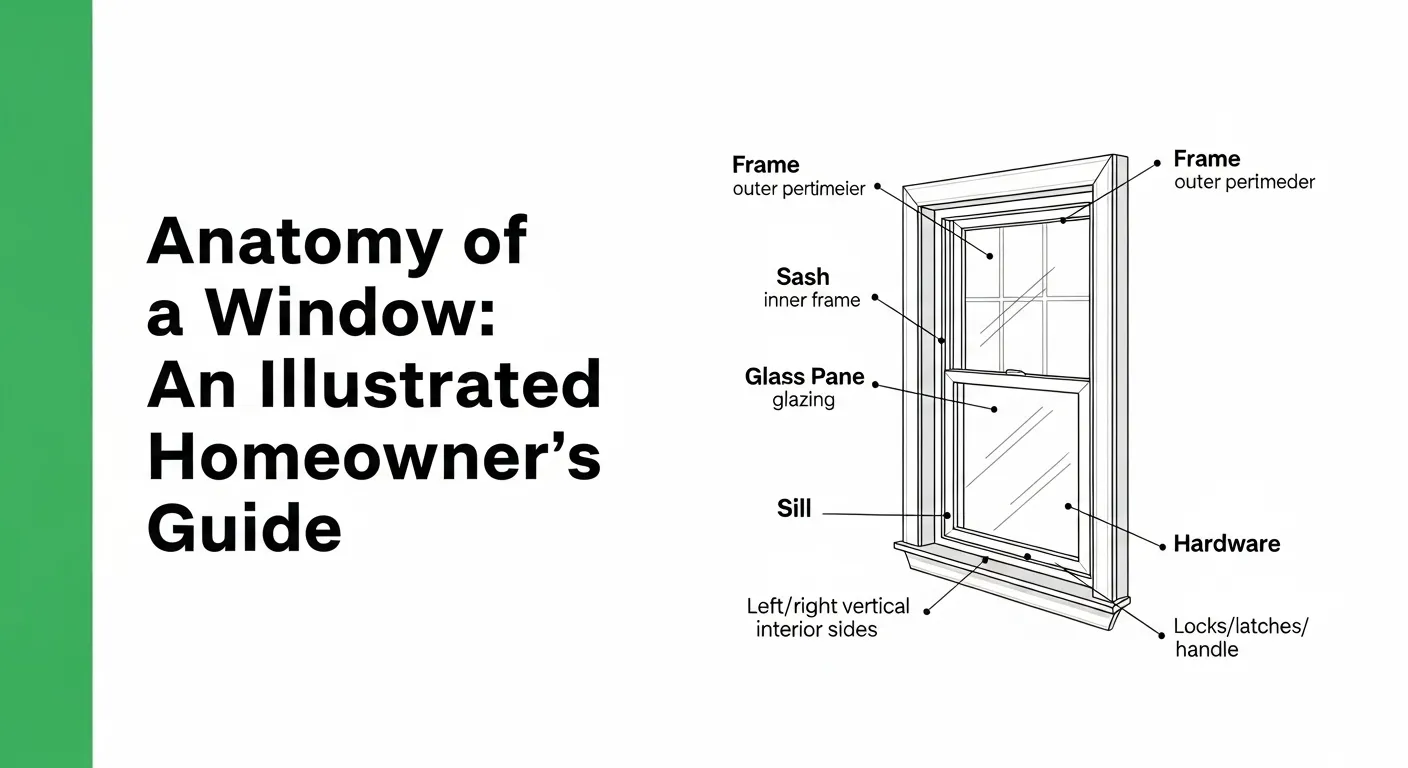きちんと シングルハンギングウィンドウの密閉、断熱、固定 家の快適さ、省エネ、そして安全性には、換気が不可欠です。隙間風、熱の損失、そしてセキュリティ上の脆弱性に対処することで、一年を通して快適な住まいを実現し、光熱費の削減にもつながります。
このガイドでは、既存のシングルハンギングウィンドウのパフォーマンスとセキュリティを向上させるための、実用的で DIY に適した手順を説明します。
簡単に復習したいですか? シングルハンギングウィンドウとは何か – 上部サッシは固定、下部サッシは可動。
Windows を改良する理由: 解決される一般的な問題:
- 下書き: サッシやフレームの端から冷たい空気が侵入します。
- エネルギー損失: 冬に熱が逃げ、夏に熱が入り込むことで電気代が高くなります。(詳しくはこちら 窓のエネルギー効率).
- セキュリティ上の懸念: 適切に保護されていない場合、窓は潜在的な侵入口となる可能性があります。
- 快適: 隙間風をなくすことで、より快適な生活空間が生まれます。
必要なツールと材料
次の一般的なアイテムを集めます。
シーリングと断熱:
- ウェザーストリップ: (フォームテープ、Vストリップ/テンションシール、ゴム)
- コーキング: (外装用シリコンまたは内装用塗装可能ラテックス)&コーキングガン
- 窓断熱フィルムキット: (プラスチックフィルムと両面テープ)
- ロープコーキング: (取り外し可能なシーラントパテ)
- 清掃用品: 中性洗剤、水、布、掃除機
- ツール: カッターナイフ、はさみ、巻尺、ヘアドライヤー(映画用)
保護:
- 既存のロック: 機能することを確認してください。硬い場合は潤滑剤の使用を検討してください。
- セカンダリウィンドウロック: (鍵付き錠、スライドボルト、ヒンジ付きウェッジ錠)
- ピン/ネジ: (サッシを固定したり、開口部を制限したりするために)
- ドリル&ビット: (錠前やピンの取り付け用)
- ドライバーセット
安全性:
- 安全メガネ
- 作業用手袋
パート1:隙間風を防ぐために窓を密閉する
空気の漏れを止めることが、最も効果的なステップとなることがよくあります。
A. 漏れを見つける:
- 視覚チェック: サッシ(窓枠との接合部)の周囲と、窓枠と壁(内外)の接合部に明らかな隙間がないか確認してください。ウェザーストリップが破損、圧縮、または欠損していないか確認してください。
- ドラフトの感触: 涼しくて風の強い日に、窓の縁をゆっくりと手でなぞってみてください。冷たい空気がどこから入ってくるのか、きっと感じられるはずです。
- ドラフトテスト(オプション): 火のついた線香やろうそくを窓の縁にそっと近づけてみてください。煙や炎の揺らめきがあれば、空気漏れの兆候です。
B. シーリングソリューションを適用する:
- ウェザーストリップの取り付け/交換: これは、 動く 部品。
- クリーン: ウェザーストリップを取り付ける表面(サッシの縁、フレームの溝の内側)を徹底的に清掃します。古くて損傷したウェザーストリップは取り除きます。
- 測定とカット: 必要な長さを測ります。フォーム、フェルト、またはゴムストリップをハサミまたはカッターナイフで切ります。
- 適用する: 粘着テープの裏紙をはがし、しっかりと押し付けて固定します。V字型の場合は、サッシが枠に接触する溝に押し込みます。窓がきちんと閉まり、ロックされることを確認してください。 閉じるとわずかに圧縮されるようなぴったりとしたフィット感を目指します。
- 固定隙間をコーキングする: 隙間にコーキング剤を使用する しない 動く。
- クリーン: 古いコーキングを取り除きます。隙間やひび割れを徹底的に清掃し、乾燥させます。
- 適用する: コーキング剤を均一に塗布し、 窓枠が内壁/トリムと接する そして、 外壁フレームが外壁/トリムと接合する。 する ない 可動部分または水抜き穴をコーキングします。
- スムーズ: 湿らせた指か道具でビーズを滑らかにならし、硬化させます。
- ロープコーキング(一時的)を使用する: 季節的なシーリング(例:冬)には、サッシ周りの隙間に柔軟なロープコーキング材を押し込みます。春には簡単に取り外せます。
パート2:窓の断熱による温度管理の改善
密閉により空気を遮断しながら 動き断熱材は熱を遅らせる 移行.
- 窓断熱フィルムを貼る: 絶縁空隙を作成します。
- クリーン: 窓ガラスと枠を徹底的に清掃します。
- テープを貼る: キットの両面テープを 顔 室内の窓枠の。
- フィルムを貼る: プラスチックフィルムを慎重に広げ、上からテープにしっかりと押し付けます。表面が平らになるようにしてください。
- シュリンクフィルム: ヘアドライヤーを弱~中温に設定し、フィルムの上を前後に動かしながら当てます(フィルムに近づけすぎないように注意してください)。フィルムが縮んで透明になります。余分なフィルムを切り取ります。 (これは一時的な季節的な解決策です)。
- 保温カーテンを使用する: 厚手で断熱性のあるカーテンは、閉めた際に熱伝導を大幅に低減します。カーテンの幅と長さは、フレーム全体を覆い、窓枠や床に接する程度にしてください。
- フレームの隙間を断熱する(上級): 他の作業中にトリムが取り外された場合( 窓の交換)、窓枠と家の骨組みのスタッドの間の隙間に、低膨張スプレーフォームまたはグラスファイバー断熱材を追加できます。 これは基本的なシーリングよりも複雑です。
パート3:シングルハンギングウィンドウの固定
次の方法で窓の安全性を向上させます。
- 既存のロックを確認する: 標準のサッシロックが完全にしっかりと固定されていることを確認してください。固い場合は清掃または潤滑してください。破損している場合は交換してください。
- 二次ロックをインストールする: セキュリティポイントをさらに追加します。
- 種類: 鍵付きロック、ヒンジ付きウェッジロック、スライディングボルトは、金物店で入手できる一般的なオプションです。
- インストール: メーカーの指示に従ってください。通常は、サッシやフレームにロック部品を配置し、穴の位置をマークし、慎重に下穴を開け(特にビニール製の場合)、ネジで固定します。
- サッシュをピンで留める: シンプルで効果的な方法です。
- ウィンドウを完全に閉じます。
- わずかに下向きの角度で穴を開けます 内側 (下)サッシと部分的に 外側 (上)重なり合う部分のサッシ。
- 穴に丈夫な釘または金属ピンを差し込みます。ピンを抜くまで窓は開けられません。
- 追加の穴を開けて、換気のために窓を部分的に開けておくことができます。
- ウィンドウストップを使用する: トラックに調節可能なストップを設置して、窓の開閉範囲を制限し、安全に換気できるようにします。
重要な火災安全に関する注意事項: セキュリティ対策は、緊急時に迅速に避難できるよう確実に実施してください。避難経路となる窓は、恒久的に施錠しないでください。鍵付き錠の鍵は、すぐに取り出せるようにしておきましょう。
一般的な問題のトラブルシューティング
- 密閉後も隙間風が入る? 見落としがないか再度確認してください。ウェザーストリップがしっかりと密着し、わずかに圧縮されていることを確認してください。コーキングラインにひび割れがないか確認してください。
- ロックがきちんとかからない? ウィンドウが完全に閉じていない可能性があります(障害物/位置合わせを確認する またはキーパー/ロックの調整/交換が必要です。
- ガラス板の間に結露? これは二重窓ガラスのシーリング不良を示しています。フレームをシーリング/断熱しても改善しません。断熱ガラスユニットは専門家による交換が必要です。
持続的な結果のためのメンテナンス
詳しいヒントについては、 窓のメンテナンスガイド.
- 毎年検査: ウェザーストリップとコーキングに損傷がないか確認し、必要に応じて交換します。
- 定期的に掃除する: 適切な密閉とロック機能のために、トラックを清潔に保ちます。.
- テストロック: ロックがスムーズに動作することを確認します。
結論
対策を講じる 片開き窓を密閉、断熱、安全にする 快適性、省エネ、そして安心感において、窓は大きなメリットをもたらします。ウェザーストリップ、コーキング、窓フィルムの使用、補助錠の設置など、ほとんどの方法はDIYで簡単に行うことができます。隙間風や脆弱性に対処することで、より快適で安全な家づくりにつながります。窓枠に大きな損傷や複雑な問題が発生した場合は、窓の専門家にご相談ください。










